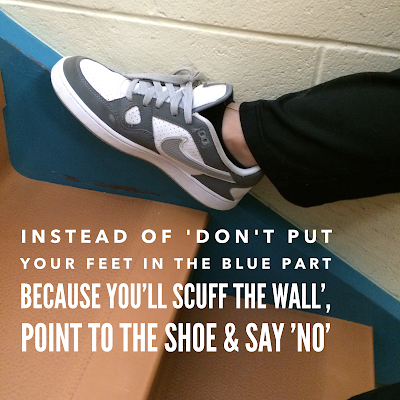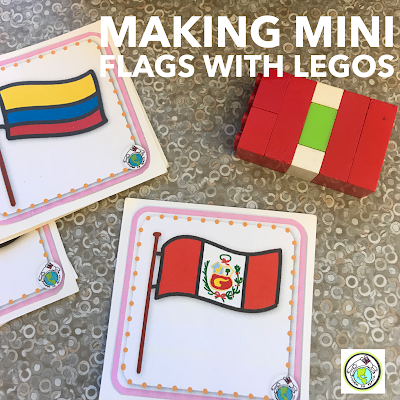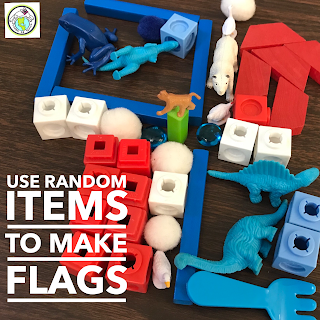I AM FREQUENTLY ASKED HOW TO KEEP CLASSROOM MANAGEMENT IN THE TARGET LANGUAGE, an area where it can be challenging to meet that 90% goal recommended by ACTFL. Here is a simple tip: KEEP IT SIMPLE.
WHEN REDIRECTING STUDENTS, we teachers often have a tendency to be a bit verbose, going into a long explanation of what needs to happen instead of boiling down the redirect to it's most concrete components-which also makes it more comprehensible more often than not. Think about all the routines and expectations you have in class, and how, regardless of how angelic your students are, often you have to redirect behaviors...now think of the actual language you use. Is it a simple command (raise your hand, sit appropriately, don't touch, etc) or is it populated with incomprehensible language that is also unnecessary to get the point across and have the desired behavior come about? These concise, concrete redirects may take a little to get used to, and may feel a little curt at first (but it's all in the tone!!), but they will pay off down the road as you are able to stay more in the target language which provides more input for students-and did you ever notice that most classroom management vocabulary, especially when boiled down, contains high frequency words?!
Win-Win!
WANT TO EVOLVE YOUR CLASSROOM MANAGEMENT VOCABULARY, but not sure how to go about it? Start by taking 3-5 redirects you use regularly and re-formulate them into concise phrases. If you are like me, it might take you a while to develop the habit of using them, so consider writing them on notecards you can post in your room or on your cart, or even put them on a ring attached to a bracelet or lanyard-this really helps! Here is a post I wrote on my top redirects-perhaps it will inspire you!
For more tips on staying in the target language, be sure to click on our category 'Teaching 90% in the target language'!
Resources for Teaching Languages to Children
Search
Kid Friendly Carnaval Activities for Spanish Classes
CARNAVAL IS A BIG CELEBRATION, WITH THE POTENTIAL TO BE A WONDERFUL CULTURAL COMPONENT of our world language classes, but it can be a challenge to find resources and links that are little kid friendly. To that end, here are some I have searched out, along with some activities that work well to integrate the celebration (and don't miss our Pinterest board with more links! click here) :
*Los Mundos de Uli has an adorable cartoon featuring el Carnaval, great for a video walk! Click here for the link on Youtube. (from Argentina)
*Lulu Delacre's book ¡Rafi y Rosi Carnaval! (also available in English) is a cute story featuring Carnaval in Puerto Rico. You can find it on Amazon here. And a huge thank you to our reader, Sara B., who shared that this book is also available on EpicKidsBooks, an online library, free for teachers! Click here.
*Another great book, by Arthur Dorros, is Tonight is Carnaval (available in Spanish as well, Por fin es Carnaval) highlighting Carnaval in Perú and featuring beautiful arpilleras as the illustrations. Available on Amazon here.
*Use songs such as Celia Cruz's 'La vida es un carnaval' for Freeze Dance, Musical Chairs, Inside/Outside Circle greeting activities, or as background while kids are doing another activity-this is a great way to incorporate music without needing to teach the lyrics-kids just enjoy the sounds and rhythms of the music. Be sure to identify where the song comes from (which country) to make that cultural connection for kids. Putumayo has a cd, Carnaval, which, although out of print, can still be found on Ebay. Pocoyó also has a version of 'La vida es un Carnaval' here :)
*Print out kid friendly photos of Carnaval from a variety of countries and use them as an interactive activity with a map, instructing students to stick them on the country you indicate (use velcro or poster putty). Once they are all on the map, you could solicit observations about similarities and differences across countries. For novices learners, a great way to do this would be to use a graphic organizer such as a T-chart or graph with columns, with general headers such as 'Has parades', 'Has costumes', 'Has dances', etc and the countries down the vertical side. Kids can then answer 'yes' or 'no' to questions like 'Does Carnaval in Colombia have parades?'... mark 'sí' or 'no' on the graph. For photos, check out our Pinterest board here.
*Masks and headpieces are a great, concrete and tangible way for little kids to learn about Carnaval. I've created a series from six different countries for kids to make in class, you can find them here!
*Cascarones are part of the Guatemalan tradition for Carnaval. Here is a post I wrote with three easy steps to make these fun confetti eggs!
*Follow @Carnaval_SA and @CarnavaldeNinos on Twitter for great authentic fotos and posts about Carnaval in Barranquilla, Colombia. And you can search the hashtag #CarnavaldelosNiños for more posts. Some incredible content is shared regularly!
*Here are some cute free printables from SpanischmitNatalia-click here to download them!
*And don't miss this great post from Fun for Spanish Teachers! Lots of wonderful activities for little learners, including a Marimonda craft!
Other ideas or resources? Please let me know in the comments! :)
*Los Mundos de Uli has an adorable cartoon featuring el Carnaval, great for a video walk! Click here for the link on Youtube. (from Argentina)
*Lulu Delacre's book ¡Rafi y Rosi Carnaval! (also available in English) is a cute story featuring Carnaval in Puerto Rico. You can find it on Amazon here. And a huge thank you to our reader, Sara B., who shared that this book is also available on EpicKidsBooks, an online library, free for teachers! Click here.
*Another great book, by Arthur Dorros, is Tonight is Carnaval (available in Spanish as well, Por fin es Carnaval) highlighting Carnaval in Perú and featuring beautiful arpilleras as the illustrations. Available on Amazon here.
*Use songs such as Celia Cruz's 'La vida es un carnaval' for Freeze Dance, Musical Chairs, Inside/Outside Circle greeting activities, or as background while kids are doing another activity-this is a great way to incorporate music without needing to teach the lyrics-kids just enjoy the sounds and rhythms of the music. Be sure to identify where the song comes from (which country) to make that cultural connection for kids. Putumayo has a cd, Carnaval, which, although out of print, can still be found on Ebay. Pocoyó also has a version of 'La vida es un Carnaval' here :)
*Print out kid friendly photos of Carnaval from a variety of countries and use them as an interactive activity with a map, instructing students to stick them on the country you indicate (use velcro or poster putty). Once they are all on the map, you could solicit observations about similarities and differences across countries. For novices learners, a great way to do this would be to use a graphic organizer such as a T-chart or graph with columns, with general headers such as 'Has parades', 'Has costumes', 'Has dances', etc and the countries down the vertical side. Kids can then answer 'yes' or 'no' to questions like 'Does Carnaval in Colombia have parades?'... mark 'sí' or 'no' on the graph. For photos, check out our Pinterest board here.
*Masks and headpieces are a great, concrete and tangible way for little kids to learn about Carnaval. I've created a series from six different countries for kids to make in class, you can find them here!
 |
| Click here |
*Follow @Carnaval_SA and @CarnavaldeNinos on Twitter for great authentic fotos and posts about Carnaval in Barranquilla, Colombia. And you can search the hashtag #CarnavaldelosNiños for more posts. Some incredible content is shared regularly!
*Here are some cute free printables from SpanischmitNatalia-click here to download them!
*And don't miss this great post from Fun for Spanish Teachers! Lots of wonderful activities for little learners, including a Marimonda craft!
Other ideas or resources? Please let me know in the comments! :)
Making Mini Flags with Legos in World Language Class
MY ELEMENTARY SPANISH STUDENTS LOVE FLAGS, and I am constantly searching for new ways to incorporate them in class. I stumbled across the idea of using Legos on Pinterest a while back but didn't act on it until I saw a Twitter post from Señora Speedy (check out her blog here!) where she had fast finishers making large flags out of Legos, which gave me the push I needed to try it myself. Since my First Graders focus on the South America map in January, it seemed like the perfect time to bring in the Legos.
I DECIDED TO STICK WITH MAKING MINI FLAGS since I wanted to do the activity with whole class at the same time, and therefore needed A LOT of Legos! I don't have any of my own, so I put out an all call to my colleagues at school, and quickly had several bucketfuls at my disposal. I parceled out bricks of the colors needed to put together the flags from South America onto paper plates, labeling each paper plate with the teacher's name from where I got those Legos so I could return them to the right bucket. (I ended up only pulling from two buckets). I made seven plates so I could divide up the class into groups of 2 or 3, thereby reducing the chance of arguing over bricks.
BEFORE STARTING, I SHOWED KIDS EXAMPLES USING DIFFERENT SIZED BRICKS, all making the same flag (Paraguay) so that they realized they didn't have to stick with just one size (this was in large part because I just didn't have enough bricks of any one size for all kids to make the same flag at the same time).
ONCE IN GROUPS, I BEGAN BY NAMING A PARTICULAR FLAG, showing it to my students and instructing them to construct it themselves using the Legos on the plate. I gave them a few minutes to put the flags together, I checked them out, and then we reviewed the colors of that flag. We then took them apart and started again. I did this activity twice, over two classes, each time lasting about 12-15 minutes tops.
DON’T HAVE LEGOS and can’t source them? No problem! Use random items like pom poms, cubes, play food, animal counters, buttons, what ever you have and put them in trays for kids to get creative! I like to have a flag posted on the Apple TV so they can see it large, and then work in small groups or pairs to create the flag I’ve indicated. Doing 5-6 flags seems a good number to do in one lesson; this also gives us the opportunity to do this activity multiple times without it feeling stale :)
I DECIDED TO STICK WITH MAKING MINI FLAGS since I wanted to do the activity with whole class at the same time, and therefore needed A LOT of Legos! I don't have any of my own, so I put out an all call to my colleagues at school, and quickly had several bucketfuls at my disposal. I parceled out bricks of the colors needed to put together the flags from South America onto paper plates, labeling each paper plate with the teacher's name from where I got those Legos so I could return them to the right bucket. (I ended up only pulling from two buckets). I made seven plates so I could divide up the class into groups of 2 or 3, thereby reducing the chance of arguing over bricks.
BEFORE STARTING, I SHOWED KIDS EXAMPLES USING DIFFERENT SIZED BRICKS, all making the same flag (Paraguay) so that they realized they didn't have to stick with just one size (this was in large part because I just didn't have enough bricks of any one size for all kids to make the same flag at the same time).
ONCE IN GROUPS, I BEGAN BY NAMING A PARTICULAR FLAG, showing it to my students and instructing them to construct it themselves using the Legos on the plate. I gave them a few minutes to put the flags together, I checked them out, and then we reviewed the colors of that flag. We then took them apart and started again. I did this activity twice, over two classes, each time lasting about 12-15 minutes tops.
IT WAS SUCH FUN, AND A GREAT HANDS ON WAY TO PRACTICE country names and colors while focusing on culture! For more activities with flags, check out my pack here:
 |
| Click here |
DON’T HAVE LEGOS and can’t source them? No problem! Use random items like pom poms, cubes, play food, animal counters, buttons, what ever you have and put them in trays for kids to get creative! I like to have a flag posted on the Apple TV so they can see it large, and then work in small groups or pairs to create the flag I’ve indicated. Doing 5-6 flags seems a good number to do in one lesson; this also gives us the opportunity to do this activity multiple times without it feeling stale :)
Subscribe to:
Posts (Atom)








